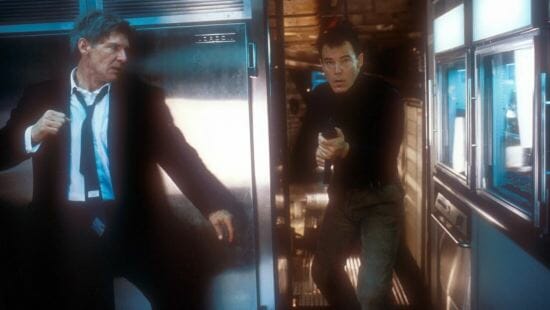In Air Force One, Harrison Ford Was the Last Action President
25 years ago, Wolfgang Petersen made the ultimate Clinton-Era action blockbuster

The only thing dumber than Clinton-era American politics has been, well, every subsequent era in American politics. But it was still a high water mark for unbearability: Try to listen to a Mark Russell parody song or watch any Saturday Night Live cold open from 1993-2001 and see how long before you punch out the monitor. Politicians have never been self-aware or relatable, ever. But 1997, the year that gave the world Air Force One, was undoubtedly a time when they were at their absolute least sympathetic. Clinton, who had won reelection in 1996, was just becoming embroiled in a sex scandal that would define the rest of his presidency.
Air Force One, a movie in which President Harrison Ford punches and machineguns radical commie terrorists and F-15s blow things up real good, is great fun to watch. Coming as it did after Independence Day, which is another hyped up jingoistic blockbuster with exploding jets and a fightin’ prez, it was also the end of an era, and not just because action fans were about to be steamrolled by Matrix knockoffs, the first successful superhero blockbusters since Batman and every Lord of the Rings imitator. Even as Air Force One was in theaters, the president the movie was transparently lionizing was on his way to being impeached and indirectly setting the country on a course for eight disastrous years of Republican rule.
It is the best “Die Hard-in-an-X” movie ever!

The movie opens on American paratroopers silently gliding into a former Soviet country’s palace to violate its sovereignty (this time it’s Kazakhstan). The logistics of this maneuver, during which a heavily armed U.S. black ops team captures the country’s radical leader and extracts via chopper, are best not looked into too closely—it turns out they didn’t need to somehow get across China to India or ask Pakistan nicely if they could just squeeze by on their way to the Arabian Sea because this was a joint military operation with Russia. (Almaty, which was the capital of Kazakhstan when the movie was made, is almost as far from the country’s border with Russia as it is possible to be while still being in Kazakhstan, but whatever.) President James Marshall (Ford) was the mastermind behind this joint operation, in which a brutal dictator has been deposed and the future of a still-not-Communist Russia has been assured.
At a fete in his honor in Moscow, Marshall reflects on the inaction leading up to the maneuver and declares that American foreign policy is now to wreck all terrorists, a position that should evoke a tired sigh from anybody watching the movie with the benefit of hindsight that the subsequent quarter of a century has granted them. Marshall’s audience loves it, his staff (who were not consulted on these talking points) hate it.
Marshall is the perfect president: Handsome, principled, multilingual, ready for a 3 A.M. phone call. Ford slides into the role like a Harvard graduate slides into a major party nomination. His comfort in the role is more notable than any of the movie’s action or plot, which, by virtue of Wolfgang Petersen directing, is matter-of-fact and competent on both those counts. We’re really here to see Ford, a guy defined by lovable rogues, employ his punching and shooting abilities while acting presidential.
The punching and shooting starts after Air Force One is boarded by an unassuming crew of Russian journalists who turn out to be ultra-radical terrorists with an assist from an inside man (Xander Berkeley, whose turncoat Secret Service agent’s deeper motivations are never given so much as a word of explanation). The hijackers are led by Gary Oldman, in one of his classic unhinged villain roles. Oldman’s motivations are pretty easy to understand: He hates America, hates Gorbachev’s Russia and explicitly wants to use the hostages aboard Air Force One to force them to free the Kazakh dictator captured in the opening scene. We are assured by Marshall’s White House staff (in particular Dean Stockwell’s Secretary of Defense), that this would cause the complete collapse of the Russian government and a return to the Cold War.
After spraying automatic gunfire all over the interior of a pressurized cabin, Oldman’s hijackers take control of the plane, but there’s a hitch: The president supposedly already escaped. When the Americans recover the presidential escape pod, he’s not there, either. The president, unwilling to abandon his family, slips out of the pod before it’s jettisoned and becomes the lone passenger aboard the plane who hasn’t been captured by the hijackers. Fortunately (as one of his military brass reminds everyone in the White House situation room), Marshall is a helicopter pilot who’s served in combat. (Unlike Clinton, one of more than a dozen presidents who never served in uniform.)
-

-

-

-

-

-

-

-

-

-

-

-

-

-

-

-

-

-

-

-

-

-

-

-

-

-

-

-

-

-

-

-

-

-

-

-

-

-

-

-









































